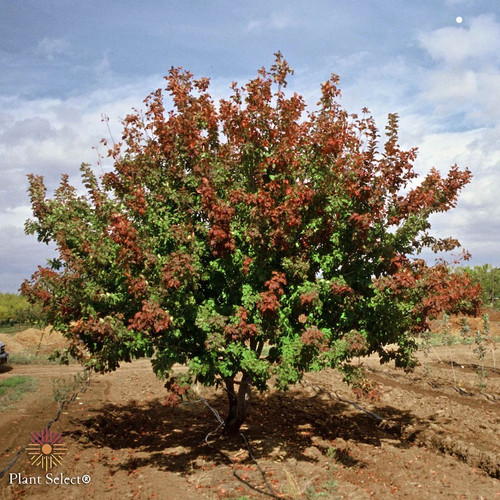
Maple Trees
Uses:
- Specimen or Focal Point
- Border Accents
- Shade Tree
Features:
- Fall Color
- Distinctive Seeds
- Fast Growing
Sunlight:
- Partial Shade to Full Sun
- 4+ Hours of Direct Sun
Growing Zones:
- 4-9
- What is My Zone?
Maple trees, encompassing the Acer genus, include over 125 different species. These deciduous trees have a pleasing rounded shape and make wonderful shade trees. The classic five-lobed leaves often turn brilliant shades of red, orange, yellow, purple, and bronze in the fall. These trees flower in the spring, attracting pollinators, while the interesting winged seeds, known as samaras, are edible and beloved by wildlife.
About Maple Trees

Depends on species
Asia, Europe, North Africa, North America
Trees
Deciduous
3 - 9
Green, Yellow, Orange, Red
Spring
Erect, Multi-stemmed, Pyramidal, Rounded
Moths, Pollinators, Songbirds
Drought
Deer
How To Use Maple Trees In The Garden
These stately trees boast dramatic foliage changes that progress from fresh spring leaves to eye-catching autumn shades. They come in heights ranging from compact varieties that fit in modest yards to majestic specimens offering ample shade. Adaptable to a spectrum of regions, maple trees often thrive in cooler climates and can withstand a range of soil conditions. Their canopy also supports local wildlife, providing both shelter and a rich food source from blossoms and seeds.
In designing your landscape, place a maple tree where you can appreciate its seasonal display, such as along a primary walkway or at the edge of a patio. Incorporate low-growing shrubs or groundcover beneath the canopy to keep roots cool and gently blend the tree into the surrounding plantings. In spacious properties, use multiple maples to form an elegant backdrop that frames your view year-round. If space is limited, opt for smaller types, which can offer the same arresting color changes without dominating the garden.
Types of Maple Tree
| Type | Scientific Name | Native | Foliage | Habit | Zones | Features |
|---|---|---|---|---|---|---|
| Japanese Maple | Acer palmatum | Japan, Korea, China | Finely to deeply lobed leaves turn fiery reds, purples, oranges in fall | Graceful small tree; rounded, many weeping or dwarf forms | 5 – 8 | Show-stopping foliage; wide cultivar range; delicate texture |
| Red Maple | Acer rubrum | Eastern & Central North America | Medium green 3-5-lobed leaves, brilliant scarlet-orange fall color | Fast-growing shade tree; rounded-oval crown | 3 – 9 | Red twigs, petioles & samaras; tolerant of wet or poor soils |
| Sugar Maple | Acer saccharum | Eastern North America | Large 5-lobed dark green leaves, glowing yellow-orange to red in fall | Majestic hardwood; dense rounded crown | 3 – 8 | Iconic Canadian maple; hard wood; best color in cool climates |
| Paperbark Maple | Acer griseum | Central China | Trifoliate leaves, blue-green above; vivid orange-red fall | Small oval-rounded tree | 4 – 8 | Cinnamon-red exfoliating bark; late, long-lasting fall color |
| Trident Maple | Acer buergerianum | E. China, Japan, Korea | Glossy 3-lobed “trident” leaves, yellow-orange-red fall | Rounded small tree; often multi-stem | 5 – 9 | Exfoliating gray-orange bark; drought, salt & pollution tolerant |
| Striped (Snakebark) Maple | Acer pensylvanicum | NE U.S. & E. Canada | Large 3-lobed leaves, bright yellow fall | Understory shrub/tree; uneven crown | 3 – 7 | Green bark streaked with white “snakeskin”; thrives in deep shade |
Maple Tree Care
Maple trees require well-draining soil and benefit from slightly acidic conditions. When planting, dig a hole as deep as the root ball and twice as wide to accommodate root spread. Regular watering is essential, especially during the first year and in periods of drought. Full sun to partial shade is ideal, with some varieties preferring afternoon shade in hotter climates to prevent leaf scorch. Fertilization is generally unnecessary if planted in nutrient-rich soil, but a slow-release fertilizer can be applied in spring if growth appears stunted.
Pruning maple trees should be done in late fall or winter to remove dead or crossing branches and to maintain structure. For winter care, apply mulch around the root zone, and in colder regions, wrap the trunk to prevent freeze-thaw damage. Growing maples in containers is feasible for smaller varieties; ensure the pot has adequate drainage and use a well-draining, acidic potting mix. Regular watering and protection from extreme temperatures are crucial for container-grown maples.
Learn More About Maple Tree Care

Maple Tree Companion Plants
Companions chosen for maples need to accept slightly acidic, well‑drained soil, dappled shade beneath the canopy, and intermittent dryness created by those thirsty surface roots. Rhododendron echoes the tree’s preference for acid ground while giving spring color. Add compact false cypress for year‑round structure without competing for head‑room. Later in the season, astilbe sends up showy plumes from the moist pockets under the branches, while coral bells paint the shade with long‑lived foliage tones that don’t mind the filtered light.












